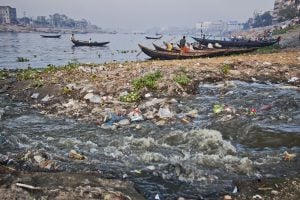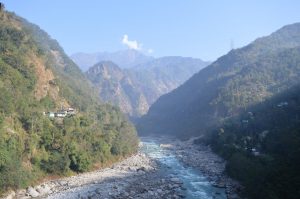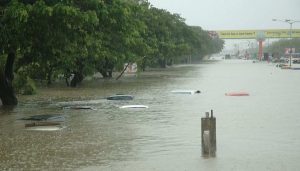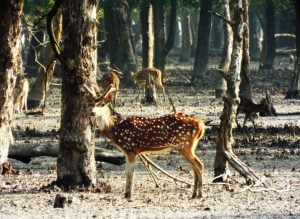On 12 December 1996, Dhaka and Delhi signed a historic treaty on sharing the waters of the Ganga that travels from Nepal and India and then into Bangladesh. Until the signing of the Ganga Water Sharing Treaty, the withdrawal of water in India caused huge environmental, social and economic consequences for Bangladesh, especially after the commissioning of the Farakka barrage in 1975.
On its twentieth anniversary, Ainun Nishat, a noted Bangladeshi environmentalist and one of the architects of the treaty, spoke to Kamran Reza Chowdhury about what were the hopes from the treaty, what has come about, and what needs to be done for the future.
Kamran Reza Chowdhury (KRC): Can you tell us about sharing the waters of the Ganga?
Ainun Nishat (AN): First of all, you have to understand a transboundary river to understand the gravity of the Ganga water sharing treaty. A river crossing more than one independent country is called transboundary. It is common that there would be conflicts over the sharing of waters of the transboundary river among the countries involved. Even states in the same country fight over common rivers. For instance, the Indian states of Telangana and Andhra Pradesh have been fighting over sharing the waters of Krishna and other rivers. Andhra is the lower riparian like Bangladesh and Telangana is the upper riparian like India.
Andhra fears that Telangana will not give it water from the common rivers, especially because water storage is possible in Telangana. On the other hand, the demand is higher in the lower part— the valley, agricultural land, settlement and city. Another problem is the sea is in the lower part. If the fresh water supply is reduced, then you will have increased salinity, and that will affect the ecology and the environment. So, the opportunities are in the upper riparian—you can store the water, you can produce hydropower, and you can maintain the navigation in the entire river. If a river crosses through two independent countries or two provinces of a same country, none of them are interested in accommodating each other’s requirements.
Added to this is the increased demand of water is the rapid growth of population in the world. We need huge quantity of water for irrigation and agriculture. Another fact is sometimes there is too much water [leading to flooding] and sometimes too little water [leading to drought, and people not wanting to share water].
KRC: How did the treaty come about?
Based on ideas from British times, in 1951 India published its plan to construct the Farakka barrage along the Bangladesh-India border. The aim of the Farakka barrage was to maintain navigability of the Kolkata port in the state of West Bengal state. Between 1960 and 1970, officials of India and Pakistan (when Bangladesh was part of Pakistan) discussed the issues that arose out of building the barrage, but they failed to thrash out an acceptable solution.
In December 1971, Bangladesh emerged as an independent country. In April 1975, India formally sought Bangladesh’s consent to go for a test run of the Farakka barrage—to see whether the barrage was constructed properly. In August 1975, Bangabandhu (Sheikh Mujibur Rahman, the founding leader of Bangladesh) was assassinated. In 1976, India went for total withdrawal of the Ganga waters causing serious problems in areas of Bangladesh including the southwestern region, which hosts the Sundarbans, the world’s largest mangrove forest in the Bay of Bengal.
In 1977 Bangladesh and India signed a five-year agreement that stressed that the two governments “need to cooperate with each other in finding a solution to the long term problem of augmenting the flow of the Ganga during the dry season”. After the expiry of the 1977 agreement, Bangladesh and India signed a Memorandum of Understanding (MoU) on 7 October 1982 for one year. Another MoU for water sharing between 1986 and 1988 was inked. The second MoU being over, there was no agreement on sharing of the Ganga waters from 1989 to December 1996 when the 30-year Ganga water treaty was signed.
You have to understand that in 1996 we convinced India to sign a treaty—not a MoU or agreement—on sharing the Ganga waters. A treaty is the strongest international legal deal between two countries. This is historic, though the treaty has some limitations.
KRC: Why is the treaty ‘historic’ and what are the limitations?
AN: Historic because India had not agreed to sign a treaty before; all the previous deals were for short terms. We do not face water scarcity during the rainy season—June to October, but during the dry season, particularly between January and May, the flow reduces drastically. So, the Ganga Water Treaty, signed by the prime ministers of Bangladesh and India, guaranteed a fair deal between Bangladesh and India. I will come to the limitation later on.
KRC: So, would you call it a good deal on water sharing?
AN: Yes, this is a fair deal. The treaty has been working, more or less, very well. I quote, “Subject to the condition that India and Bangladesh each shall receive guaranteed 35,000 cusec of water in alternate three 10-day periods during the period March 11 to May 10”. So, Bangladesh has been getting the benefits of the treaty. Of course there are rooms for improvements.
KRC: What are the limitations of the Ganga water treaty?
AN: One of the main problems or limitations of the treaty is the deal is for 30 years; this is not fair. For example: if you and your brother inherit a piece of land from your father, would you share it for 10 or 20 or 30 years? You will share it forever. What would happen after 30 years? The time-bound treaty will give India an upper hand in the negotiation in the long run. So, the treaty should have stated that ‘the treaty would be in place unless replaced by another treaty’.
Another problem is that we are sharing the residual flow at the Farakka point. The other upper riparian states such as Uttar Pradesh, Madhya Pradesh and Bihar have been withdrawing waters in the upper portion. Bihar and West Bengal have been fighting with Bangladesh, but they are not talking about withdrawal of waters in their upper portion. In the future, I fear that the Indian central government may not be in a position to ensure the minimum 70,000 cusec of water at the Farakka point for sharing with Bangladesh.
The Farakka barrage is a central government project; so the Indian central government must intervene to ensure equitable share of waters of the Ganga.
KRC: Why did you limit the treaty to 30 years?
AN: The previous deals were for short terms—from one year to five years. When we got 30 years, we thought it a big achievement.
KRC: What should Bangladesh do to amend the Ganga water sharing treaty?
AN: Bangladesh should immediately start negotiation with India on signing a better and perpetual treaty on sharing the waters of the Ganga. This is because such negotiation will take at least five to six years. But I do not see any initiative from the Bangladeshi side in this regard; the issue is yet to get importance at the decision making level. We have the experience of what happens when there is not any deal. In the past, we lost at every level of the negotiation.
KRC: Do you see a friendly approach in the future talks?
AN: Yes. Bangladesh and India have been discussing augmentation of flow of the Ganga in Nepal since 1974. In 2011 India and Bangladesh agreed to manage the Ganga basin wide. This is a big step forward to make every country understand the benefits of basin-wide management of the Ganga. We have 57 trans-boundary rivers; so this is very vital issue for us.
At present, Bangladesh needs some honest, capable, dedicated, technically sound and patriotic experts who can devise a good Ganga water sharing treaty in future.
In the line of a good Ganga treaty, we can agree with India to sign deals on other common rivers.
![<p>The creation of the Farakka barrage, 16.5 kilometres from the India-Bangladesh border, was one of the main drivers of the treaty [image by Pfly, CC BY-SA 3.0 / Wikipedia]</p>](https://dialogue.earth/content/uploads/2017/01/Ganges-Brahmaputra-Meghna_basins.jpg)








